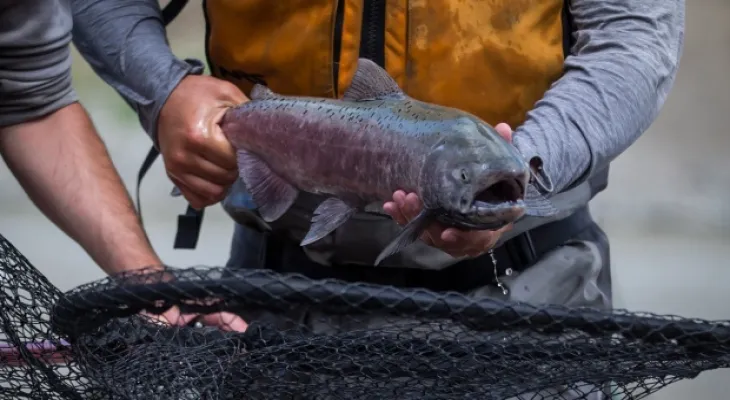Search here
Newspaper
Search here

Arab Canada News
News

Published: August 17, 2024
A fisheries expert warned that the declining water levels caused by years of severe drought, along with minimal snow cover and rainfall, put salmon in British Columbia in a critical position during their spawning migration.
Researchers are also trying to understand the effects of last year's devastating wildfires in British Columbia.
Salmon need a steady flow of cold fresh water to survive and reach spawning areas, but Murray Manson, head of the Habitat Restoration Centre for the Department of Fisheries, said in a statement on Friday that he expects fish to start showing up in some low-water areas.
He also said, "We are trying to be prepared for some issues that may arise."
Manson noted that concerns remain despite the cold spring that has left British Columbia in a "more fortunate" position than expected.
He said, "We've gotten off lightly so far, I would say, in terms of drought and its effects on fish; some areas, like the Fraser River watershed, which was expected to see historical declines in salmon numbers, are currently in a state of 'watch and wait.'
He said about the salmon, "They are still swimming in the dry conditions that exist upstream. (But) it’s early. "Things are still evolving."
The department stated that drought and heat can have a range of negative effects that are likely to impact the survival of salmon in British Columbia this year.
It said that low water levels could prevent salmon from reaching spawning areas and expose them to predators, while hot water could harm fish health, reduce spawning capacity, and make salmon susceptible to diseases.
In the Kamloops area, the Department of Fisheries said that the Habitat Restoration Centre, which works closely with First Nations, management groups, academics, and salmon advocates, aims to mitigate the effects of drought on salmon runs.
For example, on the Deadman River, the salmon restoration team is working to restore riverbank areas where black cottonwood trees are growing "so that these ecosystems can regulate water temperatures again and provide cool refuge for the fish."
On the Adams River, which the department said is home to one of the largest runs of sockeye salmon on the continent, researchers are assessing how the wildfires in the Bush Creek East area in 2023 have impacted the river and its vegetation.
The department said in a press release, "Our salmon habitat restoration team is linking images and historical maps with real-time high-precision field data collection to understand how and where post-fire conditions are affecting fish habitat, including impacts on salmon spawning conditions."
Manson said they are working on dozens of restoration projects and testing them to see what works, hoping to apply them more broadly across the landscape.
He said that while each project can be seen as a drop in the bucket, the development of techniques that can be used widely could ultimately "make a real difference."
Meanwhile, the Department of Fisheries is asking people to avoid entering dry streams as it may disturb "sensitive features."
Manson said people should act as if these streams are "still a productive habitat" for fish to ensure that plants are not disturbed.
People are also asked to manage their water use, especially during dry periods.
Finally, Manson said the department advises people not to move any fish they find stranded due to low water levels, or any fish that may be caught downstream of a dry section of a waterway. Instead, they want people to report to Fisheries through its hotline.
He said about fisheries staff, "There may be people already aware of the situation and trying to take action. We may be able in some cases to relocate adult fish, but we will have the proper equipment to do so without causing them further harm."
About 40 percent of British Columbia is experiencing drought conditions where the economic or environmental impacts are likely or highly probable, with such outcomes possible in an additional 21 percent of the province.
Comments